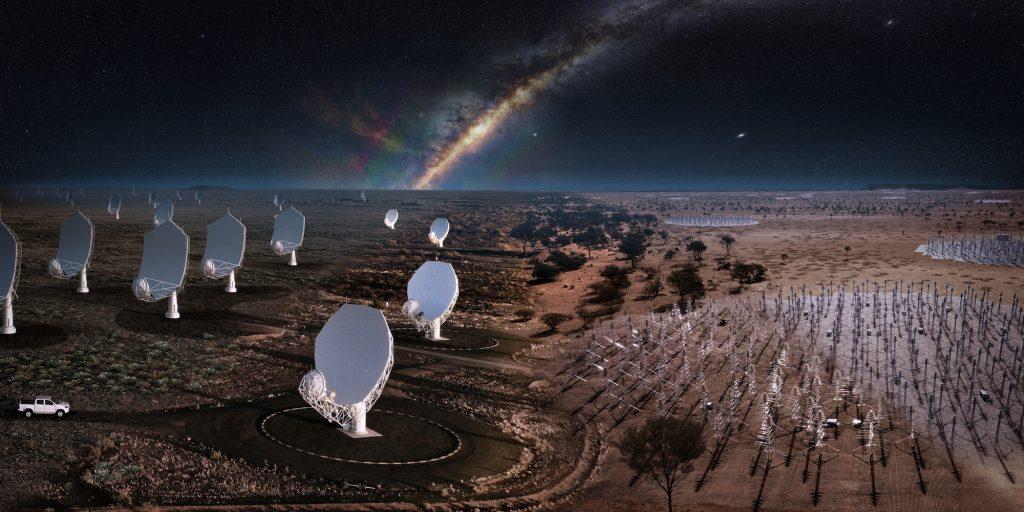SKAO and international partners petition UN for the protection of Earth’s dark and quiet skies

The paper marks the first time the protection of Earth’s dark and quiet skies has ever been tabled as a formal agenda item by the United Nations. Endorsed by Austria, Chile, Spain, and Slovakia, it will be discussed at the 59th session of the COPUOS Scientific and Technical Subcommittee currently taking place. The paper encourages the international community to protect global astronomical observing capabilities from disruptive and harmful artificial interference.
Satellites can disrupt astronomy
The night sky offers a rich tapestry of stars to the fortunate viewer, but over the last few decades, its quality has been diminished as a result of encroaching ground-based light pollution. A new threat is now emerging: the large number of satellites being introduced into low Earth orbits. As many as 100,000 satellites could be placed into these orbits in the coming decade.
These satellite systems play a range of important roles, including in enabling global communications networks. However, in some areas, these satellites can disrupt astronomy because of the sheer number of them, their brightness in the sky, and their ubiquitous radio emissions. In particular, they can affect measurements that require twilight observation, such as searches for Earth-threatening asteroids.
By the 2030s, at any typical mid-latitude observatory more than 5,000 satellites could potentially be located above the horizon at any given moment. Of those, thousands could be illuminated affecting all-optical wide-field images obtained at twilight, perhaps with the exception of those taken by the smallest optical telescopes.
Large constellations of satellites also pose a challenge to radio astronomy. Though certain narrow frequency bands are protected by the International Telecommunication Union (ITU) and some telescopes are located in protected radio-quiet zones, the sheer number of new satellites will result in thousands of additional radio transmitters moving rapidly across the sky. These are bound to affect measurements made by highly sensitive radio telescopes.
Paper outlines four main actions
There is a clear need for better global coordination, policies, and laws for dark skies protection, but also for radio-quiet skies. The paper presented to the COPUOS subcommittee for consideration outlines four main actions to combat the impact of satellites on astronomical observatories:
- recognising that ground and space-based astronomical research constitute an instrumental part of space exploration;
- raising the attention of governments to the harm created by the uncontrolled expansion of artificial light at night;
- supporting the adoption of the set of voluntary best practice guidelines for satellite constellation operators, and
- ensuring that the “impact of satellite constellations on astronomical facilities” is included in the agenda of the Scientific and Technical Subcommittee until the issue is satisfactorily resolved.
The paper was co-signed by the SKAO, the European Southern Observatory (ESO), and the International Astronomical Union (IAU). The ongoing COPUOS session marks the first one that the SKAO attends as a permanent observer after being granted this status in December 2021.
International delegates at the meeting will have the chance to digest, discuss, and outline potential future actions relating to the protection of the dark and quiet skies. The discussion is a key step in engaging international policy-makers in global protective measures for astronomy.
International & collaborative effort needed
An international approach is vital for protecting the dark and quiet skies. Collaborative efforts are required from governments, industry, and astronomers. Even private citizens, whose access to the sky should be preserved for important cultural and heritage reasons, have a part to play in the campaign.
“The SKAO is playing a leading role in protecting quiet skies,” said the SKAO’s Director-General, Prof. Phil Diamond. “In addition to this paper and participating in COPUOS meetings as a permanent observer, we are also co-hosting an IAU Centre to mitigate the harmful effects of satellite constellations on astronomy with our US colleagues at NOIRLab. We sincerely believe our requests offer a beneficial solution to all.”
Federico Di Vruno, the SKAO’s spectrum manager and co-director of the newly created IAU centre, added: “With the SKAO’s recently granted observer status at the most important policy forum dedicated to peaceful space activities, we will be able to advocate for the protection of astronomy – and radio astronomy in particular. For the astronomical community, having a subcommittee agenda item dedicated solely to the topic of Dark and Quiet Skies is a major milestone. It demonstrates that the topic is high on governments’ space agenda.”
The recommendations outlined in the paper draw on a recent report produced by the Dark and Quiet Skies Working Group, an international collaboration led by the IAU and involving SKAO and ESO scientists and policy experts. The report looks at how policy measures can be implemented to reduce the impact of satellite constellations on astronomy.
Links
- United Nations paper
- Dark and Quiet Skies II for Science and Society Working Group Reports
- Analytical simulations of the effect of satellite constellations on optical and near-infrared observations
- SKAO teams up with NSF’s NOIRLab to co-host international centre protecting astronomy from satellite interference




